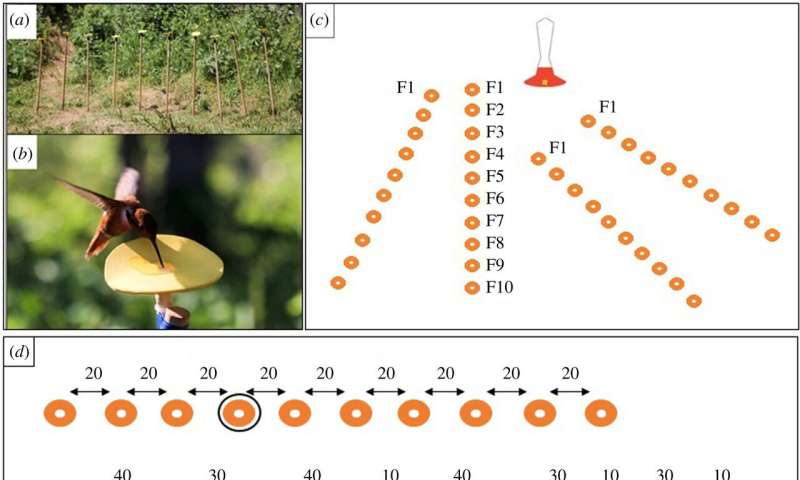(a) Photograph of an array. (b) A rufous hummingbird probing an artificial flower. Photographs: Tom Oldridge. (c) Schematic of four possible training array positions. Flower positions F1–10 were determined based on the array's orientation towards the feeder. Distance between flowers is 20 cm. Note: during the experiment, the feeder was removed. One end of each array is always closer to the feeder location than the other, allowing the birds a reference point for determining which position was rewarded. F1 in each array is always at least 60 cm away from F1 of the previous array. (d) A training array (top) and an example test array (bottom). Circled flowers are the reinforced positions (no reward provided during test trials). Note: the distance from the first flower to the rewarded flower in the training array is 60 (20 + 20 + 20) while in the test array it is 110 (40 + 30 + 40). Figures not to scale. Credit: Proceedings of the Royal Society B: Biological Sciences (2020). DOI: 10.1098/rspb.2020.1269
A team of researchers from the University of St Andrews in the U.K. and the University of Lethbridge in Canada has found that hummingbirds are able to understand the concept of numerical order. In their paper published in Proceedings of the Royal Society B, the group describes experiments they conducted with wild hummingbirds and what they learned from them.
Human beings are the only known creatures on Earth that are able to conduct complex math operations. However, other animals have been found to conduct simple math operations such as counting or sequencing—actions that require an understanding of numerical order. In this new effort, the researchers have found that hummingbirds can be added to that list.
The work involved setting up feeders containing artificial nectar to attract hummingbirds in the North American Rocky Mountains, where such birds are often found in the spring. The team allowed the birds to grow accustomed to sipping from the artificial feeders and then trapped and marked several specimens to allow for identification later in the experiment. The team then lined up 10 identical feeders, of which only the first contained nectar. They found that the birds naturally went to the first feeder to feed, and thus found their treat right away. The team then mixed up the feeders, which changed the numerical order of the feeders but not the order of the one that held the nectar. The birds continued to find it first. Next, the researchers put the nectar in a feeder in different numerical positions and discovered that the birds were able to find them first once again. The researchers suggest this indicated that the birds understood which numerical position the nectar was in regardless of where the line was, a finding that suggests that the birds understood the concept of numerical order.
The researchers claim their findings are the first demonstration of numerical order understanding in a wild vertebrate and further suggest that such an ability could explain the extraordinary memory abilities of hummingbirds and their uncanny ability to find food in a methodical manner.
More information: Tas I. F. Vámos et al. Numerical ordinality in a wild nectarivore, Proceedings of the Royal Society B: Biological Sciences (2020). DOI: 10.1098/rspb.2020.1269
Journal information: Proceedings of the Royal Society B
© 2020 Science X Network
























